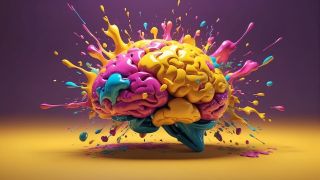ADHD
AI Finds Potential Biomarker for ADHD from Brain Scans
Machine learning finds differences in MRI scans of adolescent brains with ADHD.
Posted December 17, 2023 Reviewed by Lybi Ma

Artificial intelligence (AI) machine learning is making a difference in advancing neuroscience and healthcare research. Attention deficit hyperactivity disorder, ADHD, is a common childhood neurodevelopmental disorder. Recently, a new study presented at the recent annual meeting of the Radiological Society of North America shows how AI finds potential digital biomarkers to help identify ADHD from adolescent MRI brain scans.
Children with ADHD often struggle with holding attention and may be easily distracted, forgetful, restless, hyperactive, and impulsive. An estimated 6 million American children were diagnosed with ADHD between 2016-2019 according to the U.S. Centers for Disease Control and Prevention, the CDC. The risk factors and exact cause of ADHD are not yet proven according to the CDC. Six out of ten children with ADHD had at least one other mental, emotional, or behavior disorder, such as anxiety, depression, autism spectrum disorder, and Tourette's syndrome, and roughly half of the children with ADHD had a behavioral or conduct problem in a 2016 U.S. parent survey according to the CDC.
This study was performed by Justin Huynh, M.S., a research specialist in the Department of Neuroradiology at the University of California, San Francisco, and medical student at the Carle Illinois College of Medicine at Urbana-Champaign, along with co-his authors.1 Said Huynh in a statement,
“ADHD is extremely difficult to diagnose and relies on subjective self-reported surveys. There is definitely an unmet need for more objective metrics for diagnosis. That’s the gap we are trying to fill.”
The team of scientists used an AI deep learning model and image data from diffusion-weighted imaging, a type of magnetic resonance imaging that uses diffusion of water molecules to create contrast in the images. Diffusion-weighted imaging measures the random Brownian motion of water molecules within a voxel of tissue. A voxel is the three-dimensional equivalent of a pixel.
The study used data from over 1700 individuals with and without ADHD in the database from the multi-institutional Adolescent Brain Cognitive Development Study. For 30 main white matter paths in the brain, the scientists calculated how water molecules move along the fibers and extracted fractional anisotropy measurements, which were used to train an AI deep-learning algorithm.
The researchers discovered that on over 333 patients assessed (193 with ADHD and 140 without), there were elevated FA values in nine out of the 30 white matter paths. Not only has this level of detail never been seen before, but according to Huynh, these nine white matter paths are associated with ADHD symptoms.
According to the scientists, the clinical applications are promising.
“This method identifies microstructural deviations in patients’ DWI in an unsupervised manner, providing a promising step towards finding imaging biomarkers that can be used to diagnose ADHD in a quantitative, objective diagnostic framework.”
Copyright © 2023 Cami Rosso All rights reserved.
References
1. Carle Illinois College of Medicine at Urbana-Champaign co-authors: Pierre F. Nedelec, M.S., M.T.M., Samuel Lashof-Regas, Michael Romano, M.D., Ph.D., Leo P. Sugrue, M.D., Ph.D., and Andreas M. Rauschecker, M.D., Ph.D.


